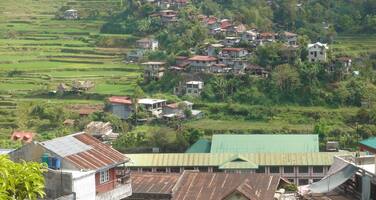Rice Terraces of the Philippine Cordilleras
Factors affecting the property in 2000*
- Impacts of tourism / visitor / recreation
- Management systems/ management plan
Factors* affecting the property identified in previous reports
- Negative impact on the site and its inhabitants due to increasing tourism
- Need for a long-term integrated development plan
International Assistance: requests for the property until 2000
Total amount approved : 78,200 USD
| 1998 | GIS for mapping the Rice Terraces of the Philippines ... (Approved) | 50,000 USD |
| 1997 | Preparation of a technical project for the mapping of ... (Approved) | 15,000 USD |
| 1994 | Preparation of a nomination file for Cordillera Rice ... (Approved) | 13,200 USD |
Missions to the property until 2000**
Conservation issues presented to the World Heritage Committee in 2000
At the twenty-third session of the Committee, the Observer of the Philippines assured the Committee that the long-term integrated development plan of the site, including a tourism development plan for the site, would be submitted to UNESCO before 15 September 2000. At the time of preparation of this working document, this report has not been received by the Secretariat.
The World Heritage Centre was informed in June 2000 that an expert Geographic Information System (GIS) consultant had completed an assessment of the terms of reference for the GIS mapping of the site which included a framework for the integrated management of the cultural heritage resources within their total environmental context. The requisite computer hardware to set up the GIS facility on-site was purchased. In November 1999, the GIS consultant conducted introductory training on the use of GIS for staff members of the Banaue Rice Terraces Task Force, the interim government agency responsible for the site’s conservation. Advanced GIS software would be provided free-of-charge by ESRI, under a UNESCO-ESRI agreement. The national authorities are currently negotiating with the UNDP Manila Office to provide additional funds required to set up an integrated resource management system in Ifugao and the Mountain Provinces, using the World Heritage GIS as its base.
However, the UNESCO Regional Office in Bangkok has expressed concern regarding the sustainability of the GIS project and consequently for the management of the site as a whole. This concern is caused by the ad hoc nature of the Task Force and current developments which have resulted in the loss or displacement of all staff of the Task Force who have received GIS training under the World Heritage Fund Technical Co-operation grant. UNESCO’s concern was expressed in a communication sent to the Secretary of the Department of Tourism and Chair of the Task Force on 28 March 2000. The Secretary transmitted the Government’s assurance that qualified replacements for the displaced personnel will be hired and that additional internal funding would be raised to sustain the GIS mapping project. The Secretary advised UNESCO that a legislative bill is being prepared for filing in the Philippine Congress for the creation of a permanent agency to manage the conservation of the Philippine Cordilleras World Heritage site. Once created, this agency will be assured of an annual budgetary appropriation and permanent staff positions. The latest development reported by the Task Force on 3 May was a fire at their offices which may have affected the computer hardware. Damage to the computer units is still being assessed.
Summary of the interventions
Decisions adopted by the Committee in 2000
24 COM VIII.iii.35-43
State of conservation reports of cultural properties which the Committee noted
VIII.35 Brasilia (Brazil)
Peking Man Site at Zhoukoudian (China)
The Potala Palace, Lhasa (China)
VIII.36 Islamic Cairo (Egypt)
VIII.37 Roman Monuments, Cathedral St Peter and Liebfrauen-Church in Trier (Germany)
Palaces and Parks of Potsdam and Berlin (Germany)
Classical Weimar (Germany)
Hortabagy National Park (Hungary)
VIII.38 Khajuraho Group of Monuments (India) Sun Temple of Konarak (India) Petra (Jordan) Luang Prabang (Lao People's Democratic Republic) Byblos (Lebanon) Ksar Ait Ben Haddou (Morocco) VIII.39 Island of Mozambique (Mozambique) Lumbini, the Birthplace of the Lord Buddha (Nepal) Fortifications on the Caribbean Side of Panama: Portobelo - San Lorenzo (Panama) Archaeological Site of Chavin (Peru) VIII.40 Rice Terraces of the Philippine Cordilleras (Philippines)
VIII.41 Baroque Churches of the Philippines (Philippines)
VIII.42 Cultural Landscape of Sintra (Portugal)
VIII.43 Istanbul (Turkey)
Complex of Hué Monuments (Vietnam)
The Bureau may wish to adopt the following decision and transmit it to the Committee for noting:
“Considering the extremely fragile eco-system of this World Heritage Cultural Landscape, the Bureau encourages the national authorities to give priority to the creation of a permanently staffed agency responsible for the implementation of the site’s conservation, preservation and development programmes, including the GIS mapping of the site and its heritage resources. The Bureau requests the State Party to report, through the Secretariat by 30 April 2001, on the establishment of this permanent agency and on the progress of the GIS mapping project at its twenty-fifth session.”

Exports
* :
The threats indicated are listed in alphabetical order; their order does not constitute a classification according to the importance of their impact on the property.
Furthermore, they are presented irrespective of the type of threat faced by the property, i.e. with specific and proven imminent danger (“ascertained danger”) or with threats which could have deleterious effects on the property’s Outstanding Universal Value (“potential danger”).
** : All mission reports are not always available electronically.

